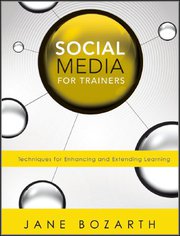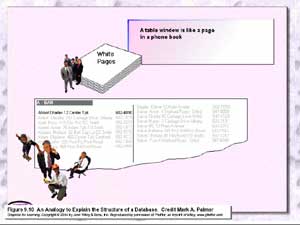Books in the News
 Social Learning and Social Media have rapidly spread throughout the learning and training world. Two of the best books on the subjects are Jane Bozarth's Social Media for Trainers (read my review) and Tony Bingham & Marcia Conner's The New Social Learning: A Guide to Transforming Organizations Through Social Media (download first chapter).
Social Learning and Social Media have rapidly spread throughout the learning and training world. Two of the best books on the subjects are Jane Bozarth's Social Media for Trainers (read my review) and Tony Bingham & Marcia Conner's The New Social Learning: A Guide to Transforming Organizations Through Social Media (download first chapter).
Today, networks of knowledgeable people, working across time and space, can make informed decisions and solve complex problems in ways they couldn't dream of years ago. By bringing together people who share interests, no matter their location or time zone, social media has the potential to transform the workplace into an environment where learning is as natural as it is powerful. - Tony Bingham & Marcia Conner
The other topic that is starting to tread is mobile learning. Gary Woodill has a new book on the subject, The Mobile Learning Edge: Tools and Technologies for Developing Your Teams. While Gary's book is aimed more at leaders who need a good strategy for implementing mlearning, Clark Quinn's soon to be released, Designing mLearning: Tapping into the Mobile Revolution for Organizational Performance, is aimed more at instructional designers who must design and execute the strategy.
For other important topics, see the Knowledge, Performance, and Learning Reading List.
Leaving Microsoft to Change the World: An Entrepreneur's Odyssey to Educate the World's Children
In Leaving Microsoft to Change the World: An Entrepreneur's Odyssey to Educate the World's Children, John Wood takes a backpacking trip through Nepal and during his journey he discovers that the local children have very few books to read. The few books that they do have are kept under lock and key. So he makes a promise to bring back a few books on his next trip. He does more than that — he quits his job at Microsoft and creates "Room to Read," a nonprofit organization that has established over 5,000 libraries and 400 schools. This book moves at a breath-taking speed — John Woods has probably done more work in the period this book covers than most have done in a lifetime.
And it is this furious speed that kept me engaged throughout the book. While it starts out at a normal pace, the author quickly picks up the pace as he races to build an organization for the world's children. He soon discovers that while he has enough money to keep him afloat for a few years, he is far short of the kind of money it requires to build the organization he visions. Thus, he uses every bit of his savvy business skills to raise the money for Room to Read.
Immediately after finishing this book, I read the next book, Biography of a Bird Dog
Biography of a Bird Dog
In Biography of a Bird Dog, Garry Wallace needs a new bird dog as his old one, Ebenezer, is getting on in years. While this book is about him training his new bird dog, Valley Girl, it is also much more as the author also reflects on his own life and the small town in Wyoming in which he lives. And since the training of a bird dog takes a steady, but set pace, this book moves a lot slower than the previous reviewed book, Leaving Microsoft to Change the World, yet the pace and timing fits the story perfectly.
Reading the two books back-to-back was like a juxtaposition of the tempo of life. On one side, do you move at a slow but deliberate speed in order to find all the answers before deciding upon a new program? Or do you not worry about having all the answers and thus move at a neck-breaking speed in order to create something?
If Wood built Room to Read at the pace of training a bird dog, he would probably just have a couple of libraries built by this time. However, if Wallace trained his bird dog at the pace Wood built Room to Read, he would have a dog with no bird hunting abilities within her. . . and a pretty messed up dog at that.
And I would venture to say that organizations are the same — some move quite rapidly while others move at a slower, but steady pace. And depending upon the organization, the pace in which they move may be perfect for them, while others are moving at the wrong pace (and thus fold long before they should).
For example, the troubled mortgage industry shows what happens when organizations move too fast in order to take advantage of something (in this case low interest rates). Yahoo! and Altavista are examples of moving much too slow when Google hit the web. Thus it becomes quite interesting at exactly what tempo an organization and the people within it should take when deciding on a new venture, rather it be a training or development program, a trend in the industry, or a competitor.
By the way, if you are getting tired of reading training and performance books, both Wood and Wallace's books are excellent reads.
Graphics for Learning
Graphics for Learning by Ruth Colvin Clark and Chopeta Lyons start with the premise that people learn better from words that are enhanced with the right graphics. Note that I highlighted the word right — this is because text and graphics do not cause better learning — it must be the correct graphic (see Richard Clark's Learning from Media: Arguments, Analysis, and Evidence (2001)).
 Clark and Lyons show how to design effective graphics for print, online, and computer-generated materials, such as multimedia, texts, performance aids, and slides that to help to maximize the learners understanding. While the book is loaded with graphics, it also comes with a CD that has colored and animated versions of all the graphics in the book.
Clark and Lyons show how to design effective graphics for print, online, and computer-generated materials, such as multimedia, texts, performance aids, and slides that to help to maximize the learners understanding. While the book is loaded with graphics, it also comes with a CD that has colored and animated versions of all the graphics in the book.
The book is divided into four main sections:
- The Foundation
- Visuals to Support Psychological Learning Processes
- Visuals for Content Types
- Planning and Communicating Your Visuals
Highly recommended for instructional designers.
Simulations and the Future of Learning
Simulations and the Future of Learning by Clark Aldrich (2004)
Rather than writing a reference book, Clark Aldrich takes us on an interesting adventure into the world of virtual learning by telling us his story of developing a leadership simulation. The book does not delve too much into the technical aspects of simulations, which makes it highly readable. However, this lack of technical details is quite noticeable in that it leaves one wanting to understand the underlying architecture. Thus, this is a great book for understanding simulations. However, if you actually want to build a simulation, you are going to have to find a more technical resource. The other main down side to the book is that Aldrich tries to make us believe that simulations are the only way to learn. . . where as I would say that they are one way for us to learn.
In addition to being a book on simulation, it also covers leadership, in addition to it being great example of storytelling.
In the book, Aldrich defines leadership as a meta-skill -- a skill about skills with the following groups:
- Power Skills: such as negotiating, traditional sales, consulting, writing, and communication.
- Idea Skills: such as brainstorming, research, listening, benchmarking, root cause analysis, marketing, empowering, and strategic planning.
- Tension Skills: such as public speaking, dealing with difficult customers, stress management, conflict management, safety, change management, and sexual harassment prevention.
- Work Skills: such as project and time management and streamlining business processes.
This is probably one of the better books on leadership since it tells a real-life story of building a training program that will develop leadership skills.
And finally, since it is actually a story, it tends to stick as it uses the technique of storytelling.
Next Step
A reading list for knowledge, performance, and learning designers
Reture to the Learning, Instructional Design & Training main page


